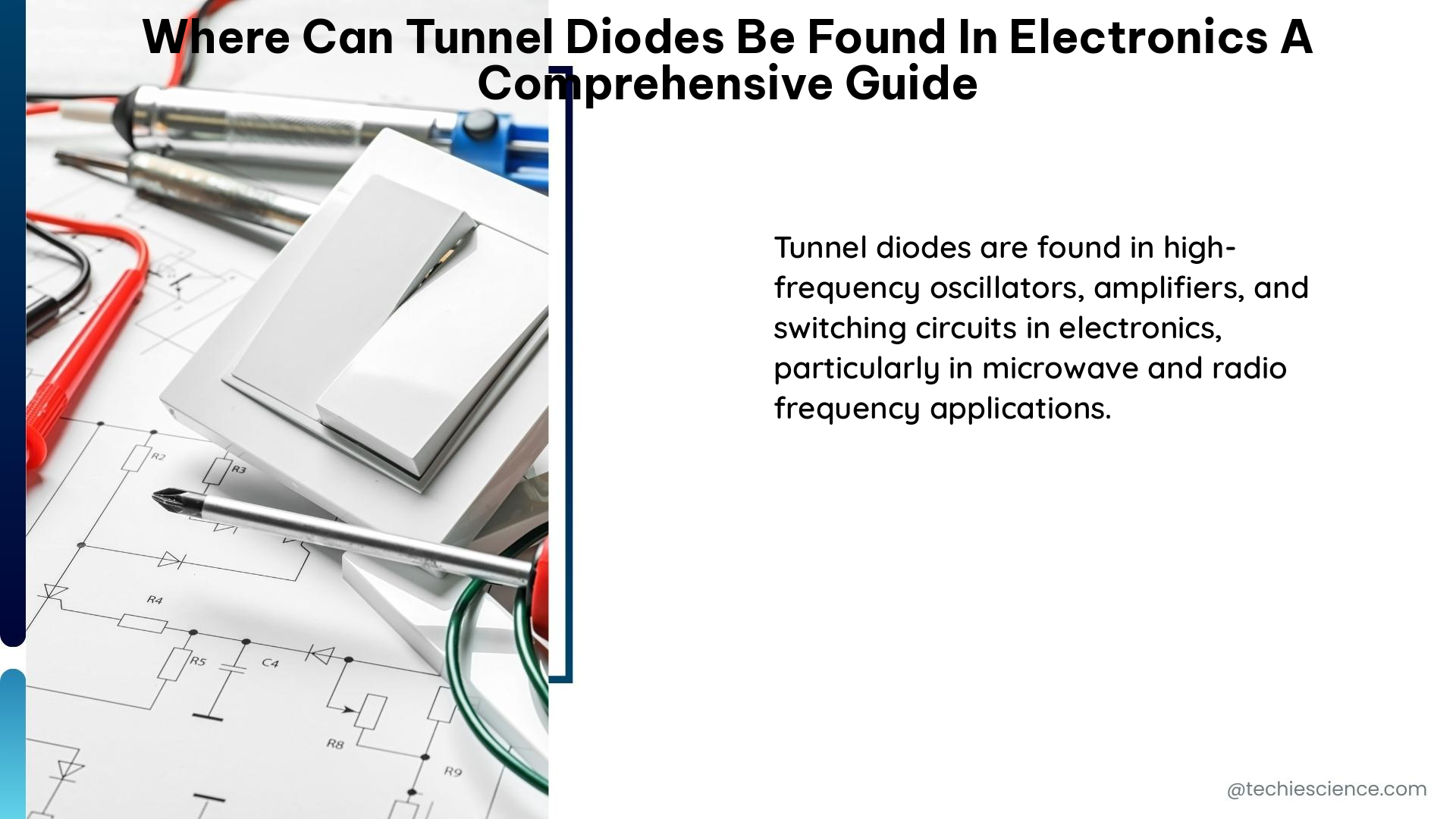Tunnel diodes, also known as Esaki diodes, are a unique type of semiconductor diode that exhibit “negative resistance” due to the quantum mechanical effect of tunneling. This property allows them to function as oscillators, amplifiers, and switches in various high-frequency electronic circuits and applications.
Understanding Tunnel Diodes
Tunnel diodes are made using different structures and materials, each with its own advantages and characteristics. These include:
-
Single-Well Tunnel Diode: This is the most basic type of tunnel diode, consisting of a heavily doped p-n junction. The narrow depletion region allows electrons to tunnel through the junction, resulting in the negative resistance behavior.
-
Double-Barrier Tunnel Diode: This diode has two potential barriers separated by a thin layer of semiconductor material. The double-barrier structure allows for higher-frequency operation, making it suitable for millimeter-wave oscillators.
-
Superlattice Tunnel Diode: This diode is made by alternating thin layers of different semiconductor materials, creating a superlattice structure. This design can enhance the tunneling effect and improve the diode’s performance.
-
Resonant Tunnel Diode: This diode has a double-barrier structure with a thin layer of semiconductor material between the barriers. The resonant tunneling effect in this structure allows for high-frequency operation and negative resistance.
-
Esaki Inter-Band Tunnel Diode: This diode is based on the inter-band tunneling of electrons between the valence band of one semiconductor material and the conduction band of another. It is used for higher-frequency applications.
Characteristics of Tunnel Diodes

Tunnel diodes have several key characteristics that define their performance and applications:
-
Peak Current (Ip): This is the highest current in the negative resistance region of the voltage-current characteristic curve. Typical values range from a few milliamps to several hundred milliamps.
-
Valley Current (Iv): This is the lowest current in the negative resistance region. The ratio of peak current to valley current (Ip/Iv) is an important figure of merit for tunnel diodes.
-
Peak Voltage (Vp): This is the voltage at which the maximum tunnel current flows. Typical values range from a few millivolts to a few hundred millivolts.
-
Valley Voltage (Vv): This is the voltage at which the tunnel current starts decreasing after the peak voltage level.
-
Capacitance: Tunnel diodes have very low capacitance, typically ranging from a few picofarads to tens of picofarads, depending on the specific diode.
-
Frequency Range: Tunnel diodes can operate at frequencies up to several hundred gigahertz, depending on the specific diode and application.
Applications of Tunnel Diodes
Tunnel diodes have been used in a variety of electronic circuits and applications, including:
-
Oscillators: Tunnel diodes can be used to create high-frequency oscillators, particularly in the microwave and millimeter-wave frequency ranges. Their negative resistance property allows them to generate stable oscillations.
-
Amplifiers: Tunnel diodes can be used as amplifiers, taking advantage of their negative resistance region to provide gain at high frequencies.
-
Switches: The hysteresis behavior of tunnel diodes can be used to create fast, reliable switching circuits, such as in trigger circuits and pulse generators.
-
Frequency Converters: Tunnel diodes can be used as frequency converters, mixing high-frequency signals to produce lower-frequency outputs.
-
Detectors: The nonlinear voltage-current characteristics of tunnel diodes make them useful as detectors, particularly in high-frequency applications.
-
Tektronix Gear: Tunnel diodes have been used in various Tektronix electronic instruments, such as sampling systems, troubleshooting circuits, and in-circuit testing using digital multimeters.
-
UHF Television Tuners: Tunnel diodes have been used as local oscillators in UHF television tuners, taking advantage of their high-frequency capabilities.
-
Oscilloscope Trigger Circuits: Tunnel diodes have been employed in the trigger circuits of oscilloscopes, leveraging their fast switching capabilities.
-
High-Speed Counter Circuits: The high-speed switching of tunnel diodes has made them useful in high-speed counter circuits.
-
Fast-Rise Time Pulse Generator Circuits: Tunnel diodes can be used in pulse generator circuits to produce fast-rise time pulses.
Conclusion
Tunnel diodes are a unique and versatile type of semiconductor diode that have found numerous applications in high-frequency electronics due to their negative resistance behavior and low capacitance. From oscillators and amplifiers to switches and frequency converters, tunnel diodes have played a significant role in the development of various electronic circuits and systems, particularly in the microwave and millimeter-wave frequency ranges.
References
- Wikipedia. (n.d.). Tunnel diode. In Wikipedia. https://en.wikipedia.org/wiki/Tunnel_diode
- ScienceDirect. (n.d.). Tunnel Diode – an overview. In ScienceDirect Topics. https://www.sciencedirect.com/topics/earth-and-planetary-sciences/tunnel-diode
- Yale Collections Discovery. (n.d.). Tunnel diodes. In LUX: Yale Collections Discovery. https://lux.collections.yale.edu/view/concept/7f820df9-4cbc-4fb6-bfe6-c9f2ad5e154c
- TekWiki. (n.d.). Tunnel diodes. In TekWiki. https://w140.com/tekwiki/wiki/Tunnel_diodes
- GeeksforGeeks. (n.d.). Tunnel Diode. In GeeksforGeeks. https://www.geeksforgeeks.org/tunnel-diode/

The lambdageeks.com Core SME Team is a group of experienced subject matter experts from diverse scientific and technical fields including Physics, Chemistry, Technology,Electronics & Electrical Engineering, Automotive, Mechanical Engineering. Our team collaborates to create high-quality, well-researched articles on a wide range of science and technology topics for the lambdageeks.com website.
All Our Senior SME are having more than 7 Years of experience in the respective fields . They are either Working Industry Professionals or assocaited With different Universities. Refer Our Authors Page to get to know About our Core SMEs.